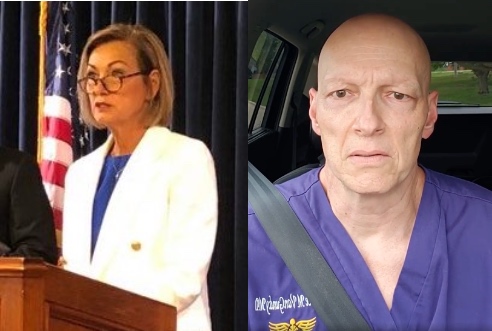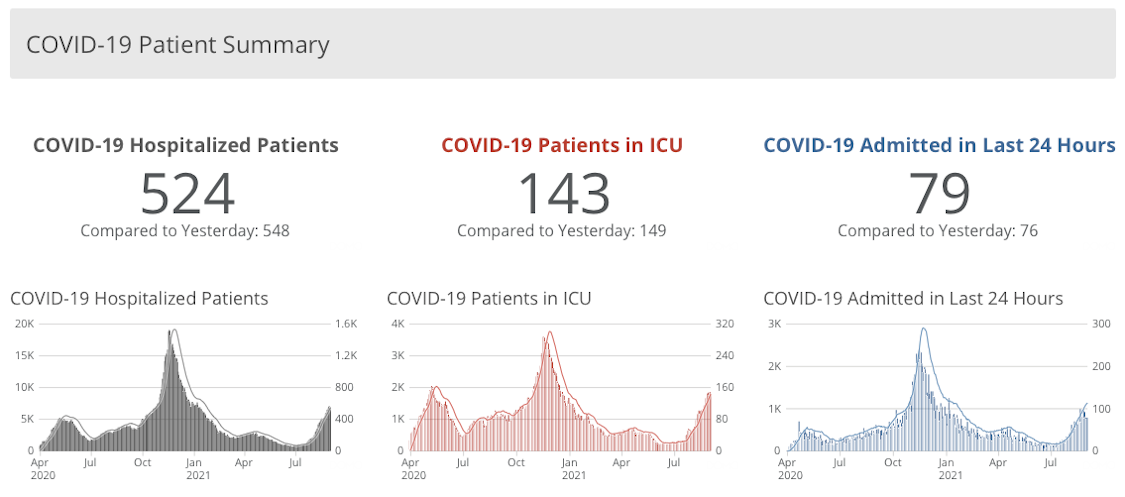Some 524 Iowans were hospitalized with COVID-19 as of September 1, according to the latest available figures on Iowa’s official coronavirus website. The first time pandemic hospitalizations reached that level here was in late October 2020. Before this week, the last time Iowa marked seven straight days with more than 500 people being treated for coronavirus in the hospital was in early January.
Governor Kim Reynolds put a positive spin on recent trends during a news conference on September 2. The same morning, Dr. Lance VanGundy, an emergency room physician at UnityPoint’s Marshalltown hospital, posted a weary assessment of the current situation on his Facebook feed.
GOVERNOR: TREND “ISN’T CAUSE FOR PANIC—FAR FROM IT”
The governor’s whole news conference is online here. The news of the day was the Iowa Department of Public Health’s decision to shift from weekly website updates to posting pandemic-related statistics three times a week. Before announcing that change, Reynolds said she wanted to “put the latest information about the virus in context.”
The governor read her opening remarks from a prepared text; this clip shows the first three minutes.
Like much of the country, Reynolds said, Iowa “is experiencing an increase in virus activity” due to the Delta variant, which now accounts for about 99 percent of the state’s COVID-19 cases.
Over the past eighteen months, the governor said, Iowans “have come to understand that this is a long game. We know that virus activity can and does fluctuate. We’ve shown we can respond and adapt without abandoning the reasonable and balanced approach that has proven effective.”
With vaccines widely available, “the rise we’re currently experiencing isn’t cause for panic—far from it,” Reynolds said. She described the increase in COVID-19 cases since mid-July 2021 as “steady, but manageable,” adding that hospitalizations have also increased “as expected.”
I would dispute that many observers predicted this sharp an increase in severe illness from COVID-19 at this stage in the pandemic. These graphs, posted on coronavirus.iowa.gov on September 1, show that hospitalizations are rising on a much steeper curve than in the late summer of 2020.
Total COVID-19 hospitalizations have increased more than tenfold since late June and are now comparable to the numbers from late October 2020, as are new daily admissions for coronavirus, which have fluctuated between 76 and 95 over the past week.
In contrast, only a little more than 300 Iowans were hospitalized with COVID-19 in late August and early September 2020, and new admissions rarely exceeded 50 a day at that time. When students went back to school last year, most districts required masks and used other mitigation measures (like hybrid schedules and quarantines) to reduce virus spread in classrooms. Now most of those policies are off the table, and the Delta variant is much more transmissible than the strains circulating a year ago.
But I digress.
Speaking at the September 2 news conference, Reynolds reminded Iowans that COVID-19 hospitalizations hit an all-time high of 1,527 in November 2020. “We don’t want to relive that experience, and thankfully, it’s unlikely that we will. The situation is different now, most notably because we have a vaccine.”
The governor went on to tout Iowa’s vaccination statistics: 66.4 percent of Iowans age 12 and older have received at least one dose of a COVID-19 vaccine, and 91 percent of Iowans at least 65 years old have done so. (With the exception of Florida, most southern states have lower vaccination rates.)
Reynolds said 79 percent of those currently hospitalized in Iowa and 90 of those currently being treated in ICUs were not vaccinated when they became infected. Those numbers show the vaccines are “highly effective” in preventing serious illnesses, hospitalizations, and death.
“Resources in some Iowa hospitals are being stretched,” she acknowledged. “In some cases it’s due to limited bed capacity,” but in other facilities it’s “because of workplace shortages.” She urged Iowans to get vaccinated to protect themselves and those around them, while ensuring that Iowans who need care for any medical problem can get it.
ER DOCTOR: “THERE ARE NO ICUs IN THE STATE OF IOWA”
Dr. Lance VanGundy looked exhausted and wasn’t reading from any script when he posted this Facebook live video on September 2.
“Hey, I feel like I wouldn’t be doing my job if I didn’t say something,” he began.
This COVID is awful. You guys know that.
There’s so much misinformation out there. We are drowning in people who are dying with this illness, and I have yet to admit a single person because of a vaccine-related incident.
I don’t want to be political, I just need everybody to really know, in over 20 years of doing this, I’ve never been this busy or this stressed or seen this many sick people.
VanGundy urged viewers to encourage others to get the vaccine. “And don’t be stupid and do dumb things, because there’s no place to admit you. If you get sick, you’re stuck with me until a bed opens up somewhere. And that might take days, because they’re all full of COVID people.”
The doctor challenged those who “get political about it and try to pretend this doesn’t affect them.” You may get a mild case, but if you pass it along to someone who becomes severely ill, “that’s a hospital bed that I can’t send a hip fracture to or a heart attack to.”
In my ER I had to hold on to a meningitis case, a stroke case, a heart attack, and a blood clot in the lung.
And these are all people that should have been transferred out to ICUs right away, and there are no ICUs in the state of Iowa. They’re all full.
So this is bad. It feels like a third world country sometimes.
VanGundy closed with one more appeal: “get your shots, people. […] That’s the only way we’re going to fix this thing.”
With new daily admissions consistently above 50 for several weeks, Iowa doesn’t appear to be anywhere near another peak of COVID-19 hospitalizations. Coronavirus patients often require long hospital stays, making it hard to bring numbers down. And state officials no longer encourage other strategies to reduce community transmission, such as face coverings. All eggs are in the vaccination basket, even as children too young for vaccines are packed into school buildings with few masks and no social distancing.
My heart goes out to all the nurses, doctors, and hospital workers who face relentless, crushing workloads because too many Iowans refused to get a shot or put on a mask in public.
UPDATE: According to New York Times data cited by Iowa Capital Dispatch, Iowa had 618 COVID-19 hospitalizations on September 2. That’s substantially higher than the 524 the state reported the previous day. Throughout the pandemic, numbers provided on the state website have often been inconsistent with those obtained through other sources.
Top image: Governor Kim Reynolds on the left (cropped from photo by Laura Belin), Dr. Lance VanGundy on the right (cropped from screenshot of his Facebook live video).


